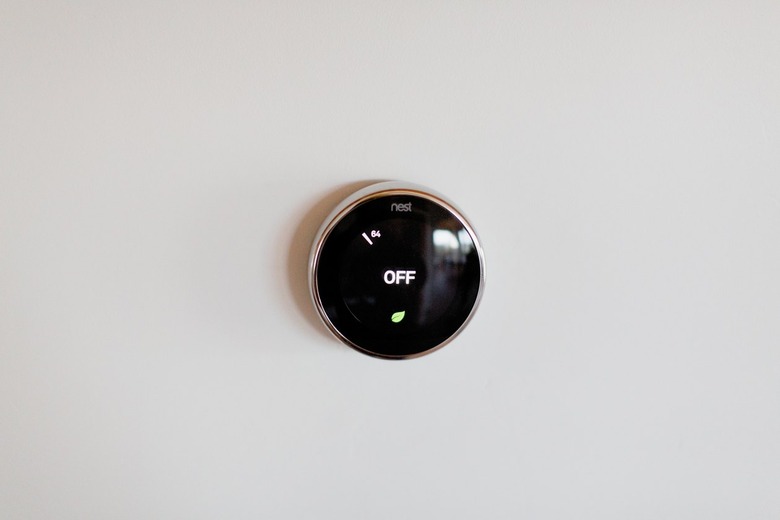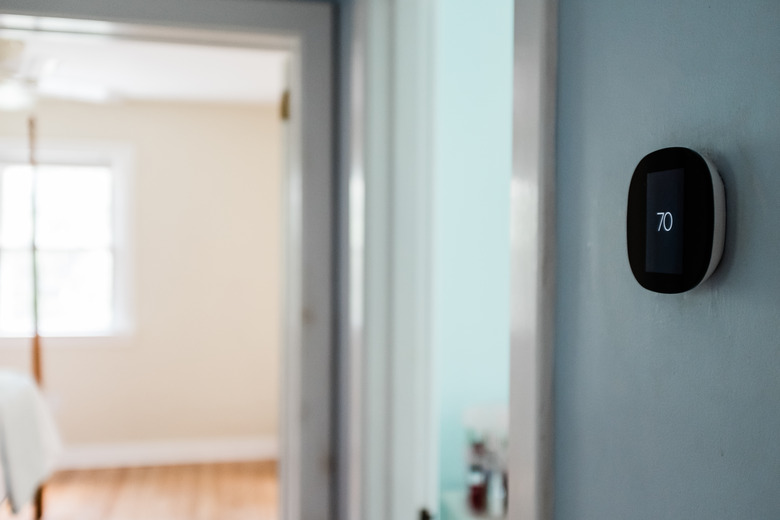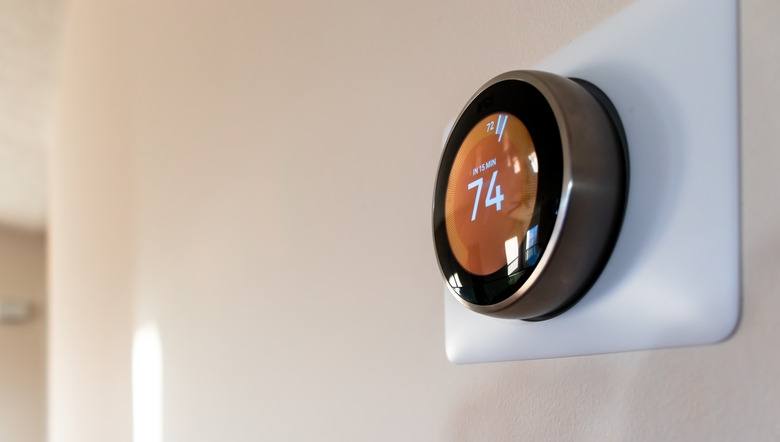How Your Home's Thermostat Actually Works
We may receive a commission on purchases made from links.
You don't have to know how your home's thermostat works to benefit from its use, but if you're installing or replacing one, it's a different story. What are all those colored wires, what do they control and why does the thermostat's location affect how well it works? The answers depend on the size of your home and its layout as well as the complexity of your central air system and the type of thermostat you have.
A basic thermostat is just a temperature-sensitive switch. It has a sensor that detects temperature changes in the room in which it's located, and it has a variable control that shuts the heating system or cooling system on or off when the temperature rises above or falls below your setting. More complex thermostats can control more than one heating zone at once. Programmable thermostats can switch the air system on and off at certain times of the day, and many can be controlled remotely. All this might sound complex, but in simple terms, a thermostat works much like a light switch and isn't much more difficult to understand.
How a Thermostat Works to Sense Temperature
How a Thermostat Works to Sense Temperature
When considering how an electromechanical thermostat (the type with manual dials) works, it's useful to think of bellows thermostats, which were standard equipment in the auto industry to keep internal combustion engines cool. When these thermostats are cool, they restrict the flow of coolant through the radiator, thus forcing the engine to warm up, and when that happens, the bellows expand to open a flange and allow more coolant to flow — all in an attempt to prevent the engine from overheating. This same principle of heat distortion is the one behind most mechanical thermostats, but instead of a rubber bellows, they employ a bimetal coil or a bimetallic strip consisting of a pair of metals with different thermal characteristics joined together.
Temperature changes distort the metals, forcing them to bend. In a common design still in use, the coil or strip tilts a horizontally suspended glass vial of mercury, which trips a switch when the mercury falls completely to one side. The temperature setting on the thermostat regulates the amount of tension needed to tip the vial. In another design, the metal strip can be made to contact a terminal when it bends, directly closing an electrical circuit that switches on the furnace.
By modern standards, an electromechanical thermostat is primitive because the metal takes a long time to respond and because mercury is toxic and disposal is problematic. Contemporary digital thermostats typically employ a thermistor, which is a semiconducting device whose electrical resistance changes with temperature. This type of temperature sensor can send an electrical signal directly to a circuit board, which does the switching electronically.
What Are All Those Wires?
What Are All Those Wires?
The simplest type of thermostat, which performs the single function of switching a furnace on and off, needs only two wires: the line wire, which carries power, and the load wire, which relays power to the furnace control panel when the circuit closes. You still see this simple setup in line-voltage thermostats, which are used to control 240-volt baseboard heaters. Modern air systems have several functions, however, and the thermostat needs several terminals and wires to be able to control all of them.
Unlike line-voltage thermostats, which are wired directly to the home's electrical circuit, most furnace and air system thermostats get 24-volt electricity from a transformer that is part of the system's control panel. When the thermostat is wired correctly by an HVAC pro, the color of each wire designates its function, and to avoid ambiguity, the terminal for each wire is labeled with the first letter of that color:
- The red wire ("R" terminal) carries 24-volt power. It's the "live" wire. Some thermostats have an "Rh" terminal for the heating system, an "Rc" terminal for the cooling system or both.
- The white wire ("W" terminal) powers the heating system. When it's connected, the furnace switches on.
- The yellow wire ("Y" terminal) connects to the compressor if your system has an air conditioner.
- The green wire ("G" terminal) connects to the blower in the furnace or air handler.
- The orange wire ("O" terminal) connects to the heat pump if the system has one. If you don't have a heat pump, you don't have to use the "O" terminal on the home thermostat.
- The common wire ("B" terminal) is usually blue, and it isn't used in every HVAC system. Some thermostats need power for the LED screen and all the programming functions, and if there's no battery, the "C" wire provides a return path for power supplied by the red wire so the thermostat itself can have power.
Although it is a type of switching mechanism, a thermostat works only to monitor room temperature and send power to the system's control module when needed. A sophisticated network of relays and switches inside the HVAC system's control module then takes over to ensure that the various components power up and down in the proper sequence and with the proper delay times. For a thermostat to keep the house comfortable, it must be located in a place that is representative of the general home environment, so it shouldn't be near a window, above a heating vent or in a sunny location.
Programmable Thermostat Features
Programmable Thermostat Features
In a sense, all thermostats are programmable because when you set the temperature, you're basically programming the conditions under which the system starts up and shuts down. However, many contemporary thermostats include internal circuitry and timers that provide many more programmable features for more functionality.
For example, some thermostats can be programmed for different temperatures at different times of the day. For example, you'd typically choose a higher temperature for early morning and a lower one for the middle of the night. Although most programmable features can be set using the controls on the face of the thermostat, some are factory set and can only be changed by reconfiguring the device.
One of these factory-set features is known as the deadband, which is a gap between the desired temperature and the temperature at which the system switches on. A deadband of 4 degrees is common, and it works like this: If the temperature control is set to 70 degrees, the cooling system won't turn on until the temperature reaches 72 degrees, and the central heating won't come on until the temperature falls below 68 degrees. The gap between 68 and 72 degrees is the deadband; it ensures the system doesn't cycle on unnecessarily — which helps save energy — and ensures the heating and cooling systems don't come on simultaneously. Mechanical thermostats, such as the Honeywell T87 line, have a variable resistor device called a heat anticipator to perform this function.
A Smart Thermostat Learns About You — And Works Remotely
A Smart Thermostat Learns About You — And Works Remotely
Smart thermostats, such as the Nest, take the concept of programmability one step further by learning from their environment. For the first few weeks, the user has to set the Nest thermostat manually, but an in-built computer algorithm allows the Nest to learn these settings, and it eventually takes over and adjusts the settings automatically, taking into account ambient conditions that affect temperature, such as local weather conditions and unusual drafts in the house caused by open windows or doors. Smart thermostats are Wi-Fi enabled, which allows users to monitor conditions remotely and alter settings as needed using a laptop or mobile device.


